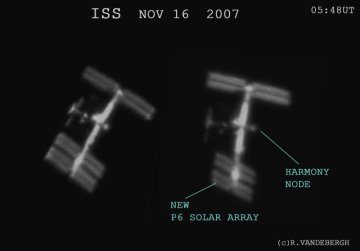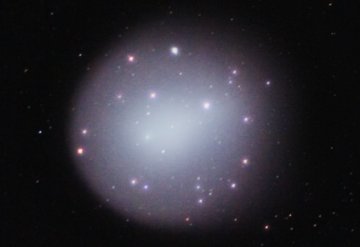 Where's Saturn? Is that a UFO--or the ISS? What's the name of that star? Get the answers from mySKY--a fun new astronomy helper from Meade. Where's Saturn? Is that a UFO--or the ISS? What's the name of that star? Get the answers from mySKY--a fun new astronomy helper from Meade. LEONID METEORS: To people who witnessed the great meteor storms of 1998-2002, the word "Leonid" is synonymous with "spectacular." Alas, this year's display is going to be weak. The Leonid debris stream is criss-crossed by rich tendrils of comet dust, but Earth will miss the richest tendrils in 2007. Forecasters expect no more than about a dozen ordinary meteors per hour when the shower peaks before dawn on Sunday, Nov. 18th. SPACE STATION: Early yesterday morning, the International Space Station (ISS) passed over the Netherlands where astrophotographer Ralf Vandebergh was waiting with his camera and a 10-inch telescope. He took these pictures: 
"My images show the station's new Harmony node and the just-unfurled P6 solar array," points out Vandebergh. Harmony was delivered to the ISS earlier this month by space shuttle Discovery and moved into its current location just two days ago by astronauts using the station's robotic arm to wrestle the 30,000-lb module into place. Future shuttles will use Harmony as a docking port. Also, two new science labs (Kibo and Columbus) are scheduled to be attached to Harmony later this year and next, further expanding the ISS and making it an even better target for astrophotography. Would you like to know when the space station is about to fly over your backyard? Sign up for Spaceweather PHONE. COMET 17P/HOLMES: "It's full of stars!" Not really, but the translucent atmosphere of Comet 17P/Holmes often looks that way when it passes in front of a rich star field. Consider this photo sent by Milan Gucic and Slavko Stojanov of Novi Sad, Serbia: 
On Nov. 19th the comet will "swallow" another star--a very bright one--when it glides in front of 2nd-magnitude Mirfak. Already the two are converging nicely: photo. The close encounter is easy to see with the naked eye, just look north after sunset for the star-fuzzball combo in Perseus: sky map. Even better, try a backyard telescope; the view is marvelous. Comet 17P/Holmes Photo Gallery
[Interactive World Map of Comet Photos]
[sky map] [ephemeris] [3D orbit] [Night Sky Cameras] | 
